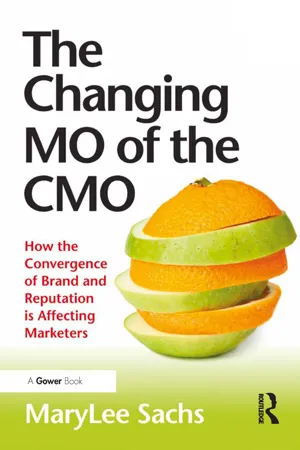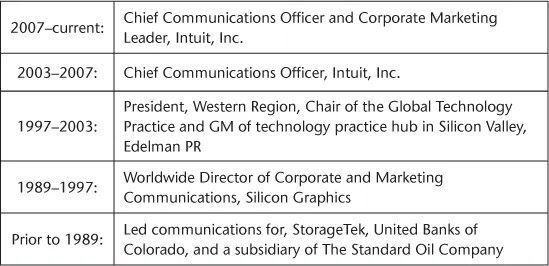![]()
1 Setting Context
There is no one right answer to the conundrum of where PR belongs in an organization. Much depends on the specific organization’s challenges and objectives, type of business, category landscape, and geographic reach. Historical silos, culture, personalities, and budgets also play factors, or can be hindrances in affecting change in organizations.
At the very least, one can assume that the traditional role of the CMO is changing and becoming more subservient to the customer, and that in turn is affecting strategy and structure across organizations. CMOs need to be sensitive to the symbiotic relationship between the traditional control of marketing and the stimulating and feeding of conversations with the target audiences in a much less controlled landscape. Marketing can no longer control the conversation and sometimes is even banned from it. Target audiences as well need to be defined much more broadly than just consumers or customers to embrace employees, professionals, experts, communities, non-governmental organizations (NGOs), legislators, and others. The traditional “push” marketing model is no longer appropriate given the circles of influence that have emerged. Conversation and participation have become vital.
Marc Pritchard, chief marketing and brand building officer of Procter and Gamble (P&G), said in the British edition of PRWeek,1 “PR focuses on building brands anywhere consumers engage with us. Stories are the most important part of the marketing mix and are what we think about first. But we will place a lot more emphasis on PR in the future, as it’s one of the most authentic ways to engage with consumers.”
In June 2009, P&G announced that brand-related external relations (ER) would report into Pritchard, leaving corporate-related ER reporting into CEO Bob McDonald. Previously, all ER functions reported into the P&G CEO. This shift was part of the formation of P&G’s Brand Building Organization that “speaks to the company’s commitment to both integration and investment in its brands.” As reported by PRWeek2 in the US, “We typically find that brand PR is the top or among the top ways that we can effectively connect with consumers,” according to Chris Hassall, global external relations officer.
When Pritchard addressed the Council of Public Relations Firms’ annual Critical Issues Forum in late 2010, he said, “I’ve seen the power of PR grow as an industry, and at P&G. In the early days, PR was about managing issues behind the scenes. In the late 1990s it was more important, but still an afterthought and used mostly to announce new product launches. It was in the mid-1990s when I led our cosmetics business that I experienced the true power of PR. I saw that PR works best when it’s fully integrated into the marketing mix. I saw how PR could build emotional connections between a brand and a consumer. I saw PR build relationships and convert people into becoming brand ambassadors... Today, in my role... we have pressed the ‘reset’ button when it comes to building brands, and PR is central to that transformation. Now, more than ever, brands and companies need authentic engagement with people, and it is PR’s time to shine.”
According to Lauri Kien Kotcher, CMO and senior vice president (SVP) of global brand development at Godiva, “Alignment around all brand messages is especially critical in the increasingly multi-channel environment we find ourselves in. Marketing, selling, human resources (HR), and personal communications messages are all blending. The number of touch points keeps growing with different timelines for message development, which also makes the challenge of maintaining consistency across key brand messages harder than ever.”
Another driver of combining forces is the seemingly permanent squeeze on budgets, forcing marketers to reassess every practice and approach in an effort to get more for the money. Interestingly, Forbes3 reports that marketers with $5 million or more budgets are less likely to control PR than marketers with smaller budgets (52 percent versus 73 percent), suggesting a natural occurrence of silos in larger organizations. Equally, whether a business is a B2C or B2B may affect the thinking about where PR resides. According to a Marketing 50 One° Report4 for its members, B2B member companies of the group were far more likely than B2C members to have PR reporting into marketing. Interestingly, dual reporting and specific corporate communications departments not under marketing were exclusive to B2C respondents. In this survey, three schools of thought emerged on organizational structure:
1. Marketing – PR is about brand and messaging, reporting to CMO.
2. Split or Dual Report – Split PR function with “customer/product” aspect reporting to marketing or single PR function, dual reporting to corporate communications and to marketing.
3. Elsewhere, but Aligned – reporting to Corporate Communications, but closely aligned to marketing.
One of the greyest areas may be internal communications which has fallen traditionally under PR. The varying degrees with which the brand is affected by its employees should help to inform strategy here. For example, retailer CMOs (together with the HR function) should have some if not total control over the internal communications function, since many employees are front-of-house and the first point of contact for the brand. They are the brand ambassadors and need to be groomed and cultivated as such. But retail or not, employees should represent an incredibly rich vein of brand advocates. Unfortunately, while having employees serve as brand ambassadors is viewed as valuable and vital, only a small group of companies currently have a fully established program to engage them in that way. In The CMO Club survey,5 70 percent of CMOs reported that they did not have an active employee engagement program. Nearly half (46 percent) reported working on developing a program, and 17 percent were not working on a program at all, but plan to at some stage. Only 58 percent of the CMOs surveyed in the Forbes Insight report6 claimed responsibility for internal communications.
Similarly, customer service and customer relations functions are in those grey areas. And corporate social responsibility (CSR), historically the domain of the corporate brand and corporate communications function, has been increasingly used to further product brand goals, often providing an emotive avenue from which to connect to consumers.
There are caveats. Heavily regulated industries like healthcare and financial services rely on the PR function for a deeper understanding of restrictions surrounding marketing communications. Issues and crises throw everything into disarray, and a seamless link with research and development departments, operations, and other business functions is critical. Guardianship of multi-market and international brands is even more important with the advent of the global social world online. Listening, messaging, and navigating the social media environment have become even more important, since a mishap in one market can quickly affect another.
There clearly is no one-size-fits-all approach, and some organizations create and recreate structures to accommodate trading environments, current needs, and personalities. For example, when American Airlines decided to combine its advertising and PR functions into a single group under the CMO in 2003, the team believed that they would be able to capture some important synergies by combining the two, especially in how brand and corporate reputation were managed as well as addressing emerging media, sponsorships, and promotions that often fell between the two functions. During this period, the airline launched a new brand strategy and tagline – “We Know Why You Fly” – and numerous campaigns, all tightly integrated with advertising, PR, social media, and marketing. The work resulted in dozens of industry awards, including the Bronze EFFIE for advertising effectiveness, as well as significant improvement in awareness, consideration, preference, and willingness to purchase scores, even during difficult times for the airline industry.
During this period, the marketing function included: advertising/corporate communications, the AAdvantage loyalty program, the airline’s website AA.com, onboard products/services, customer relationship management (CRM), reservations, customer experience and global sales/distribution, advertising sales, and in-flight products and services.
In 2010, with a new CMO coming on board, the group has been restructured and divided into two parts. The customer-facing elements of the job were moved under a new SVP in charge of customer experience, including corporate communications (including customer communications and social media), AA.com, reservations, customer experience, and in-flight services. All other remaining marketing functions moved under a chief communications officer (CCO) in marketing, underlining a growing closeness between marketing and finance. The CCO’s responsibilities include: a new market planning function, advertising, and onboard products along with pricing/yield management, international planning/alliances, and fleet planning.
According to Roger Frizzell, vice president (VP) at American Airlines, “The rapid pace of technology change and the emerging social media channels continue to change how we undertake our practice. Likewise, the decline in the economy has forced the need for us all to do more with less, leveraging our resources to the fullest.”
A white paper published by global executive search firm Spencer Stuart on “How high-performing CMOs exceed expectation”7 claims that “CMOs need to be at the forefront of a host of changes impacting companies today, including advancements in technology, changing customer expectations about companies and brands, and emerging competitive threats. With the evolution of new media and social networking, companies have to figure out how to connect with consumers and allow them to be part of the brand rather than just being communicated to about the brand. They will have to master analytics to better understand customer behaviors and develop insights to inform decision making related to customer acquisition, CRM, product and service development, pricing optimization and marketing spending.”
All of these aspects will have significant implications for marketers, and there are challenges in getting everything – and everyone – to work harmoniously together. If one agrees that marketing should own at least a part of the communications or PR piece – which include aspects like reputational intelligence, advocacy, and engagement – there’s no magic formula for making it work via organization, shared goals, and/or a reward structure. But some organizations seem to have found a successful formula for working together. The next few chapters provide insights on how some CMOs have organized their marketing functions and teams to achieve their fullest potential.
![]()
![]()
2 The Intuitive CMO: Intuit, Inc.
Intuit Inc., the American software company that develops financial and tax preparation software and related services for small businesses, accountants, and individuals, was founded in 1983 by Scott Cook and Tom Proulx in Mountain View, California. The company makes the personal finance programs Quicken, MINT, and TurboTax (and its Canadian counterpart, QuickTax), as well as small business accounting program QuickBooks. In addition, the company produce QuickBooks Point of Sale solution for small retailers, professional tax solutions ProSeries and Lacerte, and the web-based corporate workgroup productivity solution QuickBase.
HARRY PFORZHEIMER, CHIEF COMMUNICATIONS OFFICER AND CORPORATE MARKETING LEADER
Illustration 2.1 Harry Pforzheimer
Table 2.1 Harry Pforzheimer professional experience
Intuit seems to have been at this longer than most. The company, which was founded on the basis of inventing a replacement for paper-and-pencil based personal accounting, determined a new way for integrating its marketing and public relations functions when its CCO, Harry Pforzheimer, took on the additional mantle of corporate marketing leader. After over a dozen CMOs in its 28-year history, Pforzheimer found himself in the unenviable position of inheriting the marketing function, but with a life expectancy of just 18 months for the average Intuit CMO, he recognized the curse of the title and shunned it “just because [he] wanted to work here longer” and because the other model – that of being CCO, which always had a seat at the C-suite table – was working.
Pforzheimer then set about further restructuring the marketing department, decentralizing the function, and helping drive into place great marketing leadership in the business units (BUs), creating an operating mechanism to increase collaboration, and streamlining the organization, stripping out layers and duplication between the BUs and the center. The central marketing department of some 300 was streamlined to around 80 since much of what was done at the center was bet...


